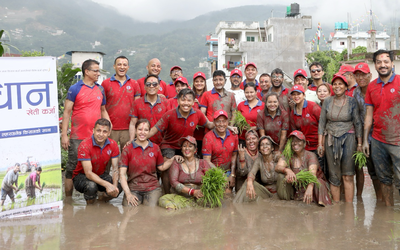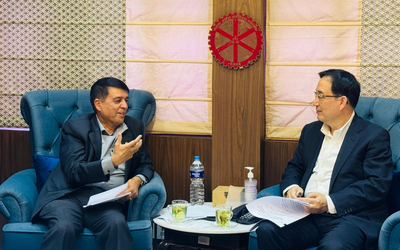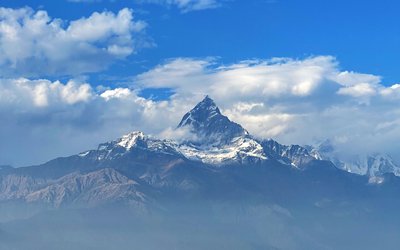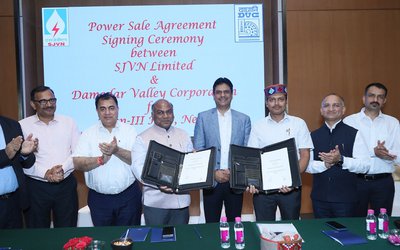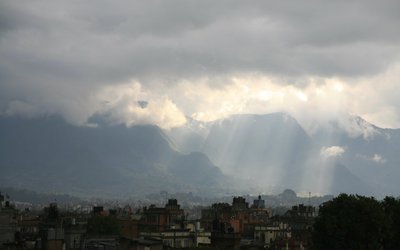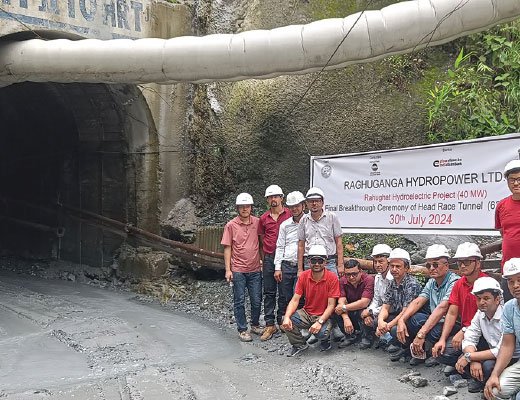

The main tunnel of the 40 MW Rahughat hydropower project under construction in Raghuganga Rural Municipality of Myagdi by the Nepal Electricity Authority has been 'break through' today.
The 'break through' of the 6,270 meter long tunnel in Rahughat, where Raghuganga Hydropower is a subsidiary company of the authority, has been 'break through'. Raghuganga Rural Municipality-4 Ganesh KC, managing director of the project, which connects the dam at the foot of Dagnam to Ward No. 3 Tilkenichaur, has been connected with a tunnel.
According to the project, four access routes (audit) were segmented and 'break through' was done while digging the tunnel route.
Bhava Bahadur Bhandari, Chairman of Raghuganga Rural Municipality and Managing Director KC jointly pressed the 'switch' and detonated the 2,332 meter long tunnel connecting the dam and Agherikhola audit no.
Eight hundred 75 meters of tunnels were constructed from Audit 1 and 1458 meters from Audit 2.
Lining (plaster) of the 3,836-meter-long second and third audit tunnels, which were connected last February, is being done.
Rural Municipality Chairman Bhandari expressed his happiness that the main work of Rahughat was the construction of the tunnel and said that he facilitated and coordinated the construction of the project.
Raghuganga Rural Municipality-3 from the outlet (end point) of the main tunnel at Pipley to the power plant under construction at Tilkenichaur, a 1049 meter long pressure soft tunnel was connected in May. A pressure shaft has been built to hold the pipeline that will take the water coming from the main tunnel to the power plant.
Construction of 61 meter deep 'search shaft' has been completed in Pipley. Tunnel construction work in hydropower project is considered as a major achievement by the technicians. Authorities, promoters, construction companies, consultants and people's representatives have expressed happiness that the tunnel has broken through. In this way, with the 'break through' of the tunnel, 60 percent of the civil work of the project has been completed, informed Raj Bahadu Bista, the head of the project.
Civil contractor Jayaprakash Associates (JP) started construction of the tunnel from Audit No. 3 at Pipley on 8th June 2076. A contract agreement was signed in November 2074 with Jayaprakash Associates (JP), the civil contractor for the project, which is being built with the joint investment of the Indian Import Export (Exim) Bank and a concessional loan of USD 67 million from the Authority and the Government of Nepal.
During the 45-month period of the contract, the deadline was extended by 30 months after the work could not be completed due to the corona epidemic, floods and landslides. The electrical contractor Heavy Electricals Limited (BHEL), which signed the contract in October 2076, has started the process of importing the equipment manufactured in India after testing it. It is said that 25 percent physical progress has been made towards the electromechanical side of the project.
Due to the weak economic situation, the contract with the old contractor IVRCL was terminated in 2072 and the construction of Rahughat hydropower project was advanced according to the company's concept and Engineering Procurement and Contract (EPC).
According to the first schedule and agreement, the project should have been completed in 2070. The hydropower project, which was previously designed at 32 megawatts, will be increased by eight megawatts to 40 megawatts.
A 17-meter high and 31-meter long semi-reservoir (PROR) technology dam and a power plant structure are being constructed at Tilkenichaur on the border of the village-4 Dagnam and Ward No. 5 Jhinko.
From the Beni-Jomsom-Korla road roundabout, an 11-km access road and a truss technology motorized bridge have been constructed to connect the power plant and the dam by a direct road.
Harish Aggarwal, the project head of civil contractor JP, said that the work has been accelerated with the aim of producing a trial of Rahughat within a year.
- Supreme Court upholds appointment of 52 officials
- Jul 03, 2025
- Weather Forecast: Generally Cloudy In The Hilly Areas With Heavy Rainfall In Some Areas Of Bagmati And Koshi Province
- Jul 03, 2025
- MCA-Nepal Welcomes Continued U.S. Support for MCC Nepal Compact Implementation
- Jul 02, 2025
- Sutlej to sell electricity from Arun III to Uttar Pradesh
- Jul 02, 2025
- PHDCCI India-Nepal Centre Organises “India-Nepal Fintech Summit 2025” In New Delhi
- Jul 02, 2025


